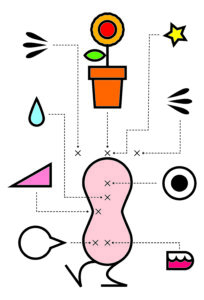Erlangen, 15.-17. November 2013
8. Annual Conference of the Society for Comics Studies (ComFor)
Venue: Senatssaal des Kollegienhauses (Universitätsstr. 15)
Deutsche Version der Ankündigung
Program

Comics and the natural sciences: at first glance, this thematic pairing brings to mind such stock characters as the mad professor or the diabolical inventor, either performing slapstick comedy or cultivating horrific beings and shapes in the laboratory. Sure enough, from Gyro Gearloose and Faust to Dr. Mabuse, these topical figurations of scientific research and (power/)knowledge form a central part of the narrative genres that have also, and specifically, flourished in comics.
Since the boom of the graphic novel, however, real figures from the history of science have become the subject matter for graphic narratives as well. Highly complex and theoretically informed biographies of Bertrand Russell and Richard Feynman have appeared in comic form (Doxiadis and Papadimitrou, Logicomix; Ottaviani and Myrick, Feynman). Graphic novels are philosophizing about physical and mathematical enigmas (Mathieu, 3″; Schuiten and Peeters, La théorie du grain de sable), they narrate physical experiments (Tirabosco and Wazem, Sous-Sols), and the “Sachcomics” or “Graphic Guides” have dealt with the Big Bang and the evolution of the species (Harder, Alpha – Directions). And vice versa, genre elements specific to the comic are also inspiring popular science discourses (Kakalios, The Physics of Superheroes).
Thus, the comic has joined the cluster of artistic media like film and literature that interdiscursively weave together the popular and pervasive scientistic myths of the present with their underlying disciplinary and analytic frameworks. This alone would already qualify the thematic pairing of “Comics and the Natural Sciences” for a scholarly conference, particularly in these times when, more so than in the past 200 years, physics and biology are clamoring for visibility as the subject matter of literary narrativization. Yet is it not additionally valid to explore and open up a larger variety of historical and media-theoretical aspects following the specific framework of the comic itself? Is, for instance, the comic perhaps predetermined as a medium for second-order observation and metafictionalization of the natural sciences, since – contrary to the pure text or image – it is not a traditional medium of scientific knowledge production? Or have image-text combinations, for example of the diagrammatic sort, rather always played a role in the model productions of the natural sciences, which have yet to be analyzed through the theoretical means of comics studies? What about technical documentation and the mediation of knowledge through instruction manuals that consist of sequential images? And in how far do the comics of the past form an archive of historical knowledge and world models, regardless of any possible intentions of their authors?
Looking more closely, an almost limitless field of questions emerges to which the 8th Annual Conference of the Gesellschaft für Comicforschung (ComFor) intends to offer some preliminary answers and discussions. The ComFor and their local host at the Erlangen-Nürnberg University – the Erlanger Research Group for Literature and Natural Science Studies ELINAS – cordially invite you to send in your contributions and proposals. Further informations will be published on our conference website.
Abstracts
Abstracts must be limited to 300 words and should include the title and content of the paper, as well as your name, a short bio/bibliography, email address, and postal address. The papers themselves should not exceed the time frame of 30-35 minutes. All proposals may be sent via email to Clemens Heydenreich. The deadline for submission is May 20, 2013.
Forum
The conference will include a workshop forum where “work in progress reports” on upcoming and recently concluded research projects can be presented. Students and early-stage researchers are welcome. “Forum” presentations are not bound to the topic of the conference, but can freely engage with any aspects of comic studies. Abstracts should be submitted following the same guidelines described above. These contributions, however, should not exceed the time limit of 15-20 minutes.
